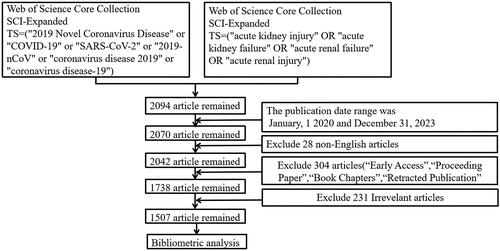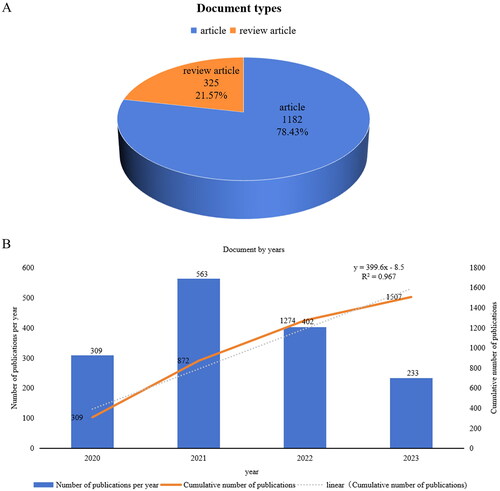Abstract
Critically ill COVID-19 patients may exhibit various clinical symptoms of renal dysfunction including severe Acute Kidney Injury (AKI). Currently, there is a lack of bibliometric analyses on COVID-19-related AKI. The aim of this study is to provide an overview of the current research status and hot topics regarding COVID-19 AKI. The literature was retrieved from the Web of Science Core Collection (WoSCC) database. Subsequently, we utilized Microsoft Excel, VOSviewer, Citespace, and Pajek software to revealed the current research status, emerging topics, and developmental trends pertaining to COVID-19 AKI. This study encompassed a total of 1507 studies on COVID-19 AKI. The United States, China, and Italy emerged as the leading three countries in terms of publication numbers, contributing 498 (33.05%), 229 (15.20%), and 140 (9.29%) studies, respectively. The three most active and influential institutions include Huazhong University of Science and Technology, Wuhan University and Harvard Medical School. Ronco C from Italy, holds the record for the highest number of publications, with a total of 15 papers authored. Cheng YC’s work from China has garnered the highest number of citations, totaling 470 citations. The co-occurrence analysis of author keywords reveals that ‘mortality’, ‘intensive care units’, ‘chronic kidney disease’, ‘nephrology’, ‘renal transplantation’, ‘acute respiratory distress syndrome’, and ‘risk factors’ emerge as the primary areas of focus within the realm of COVID-19 AKI. In summary, this study analyzes the research trends in the field of COVID-19 AKI, providing a reference for further exploration and research on COVID-19 AKI mechanisms and treatment.
Introduction
AKI is a pathological state marked by a swift deterioration in renal function, triggered by diverse factors over a relatively brief period. The chief pathological characteristics of AKI are acute renal tubular injury (ATI), discernible as an expansion of the renal tubular cavity and loss of proximal renal tubular brush edge [Citation1]. Patients with AKI present with a spectrum of clinical manifestations, ranging from mild serum creatinine and urine anomalies to multi-organ failure and even fatality. The COVID-19 pandemic represents an unparalleled challenge to global public health. From December 2019 to August 2023, this viral outbreak has amassed over 760 million cases and caused 6.9 million deaths worldwide, placing an onerous strain on countries across the globe [Citation2]. It is noteworthy that while the novel coronavirus primarily targets the lungs in most instances, its impact on the kidneys should not be overlooked [Citation3]. Currently, there exists controversy regarding whether COVID-19 primarily induces AKI through direct or indirect mechanisms [Citation4–6]. Although COVID-19 patients are predisposed to AKI, and AKI patients with COVID-19 display a strong association with a poorer prognosis, and AKI is linked to increased mortality in COVID-19 patients [Citation7]. Owing to individual variations, patients with COVID-19 AKI may exhibit diverse prognoses, ranging from renal function recovery to the onset of chronic kidney disease (CKD) and end-stage renal disease (ESRD), with severe cases even resulting in fatality [Citation8,Citation9]. Despite the growing body of research on COVID-19 AKI, there remains a dearth of literature and visual research employing bibliometric methods. Hence, this study employs bibliometric analysis to retrieve pertinent literature from the WoSCC database, aiming to elucidate the present scenario, key areas of interest, and evolving trends within the realm of COVID-19 AKI. The findings are expected to guide future investigations into the mechanisms and treatments of COVID-19 AKI.
Materials and methods
Data sources and search strategies
The literature chosen as our data source was retrieved from the Science Citation Index Expanded (SCI-E) within the WoSCC, a database developed by Thomson Reuters. The search strategy employed in this study is as follows: TS = (‘2019 Novel Coronavirus Disease’ or ‘COVID-19’ or ‘SARS-CoV-2’ or ‘2019-nCoV’ or ‘coronavirus disease 2019’ or ‘coronavirus disease-19’) AND TS = (‘acute kidney injury’ OR ‘acute kidney failure’ OR ‘acute renal failure’ OR ‘acute renal injury’). The time frame for data collection spans from January 1, 2020, to December 31, 2023, with the literature search deadline set at December 31, 2023. Following deduplication of the search results, a total of 1738 articles (comprising 1331 original research articles and 407 review articles) were acquired, subsequently undergoing screening procedures (refer to the ‘data collation and cleaning’ section for details). Ultimately, 1507 valid papers were included for analysis. Detailed information regarding the screening process is presented in and , accompanied by .
Table 1. Data sources, selection and extraction details.
Table 2. The functions and results of each link in the ‘DEAN’ process.
Data collection and cleaning
First, the original data are extracted from the SCI-Expanded database, capturing various information such as the number of papers and citations, the H-index, publication year, authors, institutions, countries/regions, journals, references, cited reference count, and keywords. Nevertheless, the extracted literature may be plagued by problems like duplication or inconsistency with the research scope. Therefore, data cleaning is indispensable to ensure the coherence and consistency required for subsequent visual analyses. This study employs the data cleaning approach – ‘DEAN’ devised by Pan Wei et al. composed of four key steps, namely, merging duplicate records, identifying and deleting erroneous entries, consolidating synonymous terms, and eliminating low-frequency terms. The ‘DEAN’ approach can effectively mitigate the negative impact of data quality problems [Citation10]. Ultimately, the refined dataset is imported into tools like Citespace, VOSviewer, and Pajek for a comprehensive bibliometric analysis.
Results
Global publication and citation trends
This study analyzed a total of 1507 articles retrieved from WoSCC focusing on novel coronavirus-related acute kidney injury, comprising 1182 original research articles and 325 review articles (). All publications were exclusively disseminated in the English language. Since the emergence of COVID-19 at the close of 2019, investigations into COVID-19-associated acute kidney injury have persistently accrued. Among them, 309 articles were published in 2020, with a total citation frequency of 31,774 times, an average citation frequency of 102.83 times, and an H index of 72. In 2021, 563 articles were published, with a total citation frequency of 14905 times, an average citation frequency of 26.47 times, and an H index of 49. In 2022, 402 articles will be published, with a total citation frequency of 2472 times, an average citation frequency of 6.15 times, and an H index of 21. In 2023, 233 articles were published, with a total citation frequency of 362 times, an average citation frequency of 1.55 times, and an H index of 7. The linear function, y = 399.6x − 8.5 (R2 = 0.967, x represents the year, y represents the annual publication), further simulates the annual publication trend, and the curve fitting is satisfactory (). Since 2022, there has been a decreasing trend in the annual number of published papers. Furthermore, there was a continued decrease in the number of papers published in 2023. This decline could potentially be associated with the WHO’s declaration on 5 May 2023 [Citation11].
Author analysis
By conducting a comprehensive review of the relevant literature, researchers can acquire valuable insights into the most productive and influential scholars in the field. Based on Price’s Law and taking into account the vast number of authors, the minimum threshold for identifying core authors in the field is established as three. This comprises a total of 336 core authors who collectively contributed to the authorship of 1233 articles, constituting approximately 81.82% of all published works. presents a comprehensive summary of the top ten authors, prominently featuring Ronco Claudio from Italy as the most prolific scholar. Throughout the period spanning from early 2020 to the conclusion of 2023, Ronco Claudio, affiliated with the University of Padua, collaborated on 15 articles, accumulating a total citation count of 653 and achieving an average citation rate of 43.53 per article. Ronco Claudio’s research interests encompass the epidemiology, management, treatment, and prognosis of COVID-19 AKI, as evidenced by his publications [Citation12–14]. In close pursuit are Duong Tim Q from the United States, Frithiof Robert, and Lipcsey Miklos from Sweden, all of whom have authored nine publications and garnered citation counts of 166, 142, and 142 respectively, securing the second position. Duong Tim Q primarily concentrates on the treatment and prognosis of COVID-19 AKI [Citation15,Citation16], whereas Frithiof Robert and Lipcsey Miklos engage in collaborative research with a specific emphasis on diagnostic and predictive indicators of COVID-19 AKI [Citation17,Citation18]. Additionally, highlights the foremost authorities in the field by presenting the most highly cited authors, encompassing the top 10 most influential individuals. Notably, the majority of authors listed are of Chinese origin, with Cheng YC from China, Hirsch JS from the United States, and Zhou F from China consistently occupying the top three positions, garnering citation counts of 470, 401, and 384, respectively. Cheng YC’s primary research interests lie in the realm of COVID-19 vaccines, antibodies, and inhibitors [Citation19–21], Hirsch JS places a special emphasis on assessing the clinical characteristics, treatment, and prognosis of COVID-19 AKI patients [Citation8, Citation22,Citation23], and Zhou F highlights the clinical course, risk factors, and treatment strategies pertaining to COVID-19 patients [Citation24,Citation25]. presents a cluster visualization generated by utilizing VOSviewer, illustrating the interaction networks among 48 authors who have authored more than five articles, thereby revealing the existence of seven distinct clusters denoting various author collaboration groups. In order to gain insights into the synergistic effects among influential authors in the field, illustrates a cluster representation comprising 52 authors whose works have garnered over 88 citations, clearly showcasing their categorization into three distinct author collaboration clusters.
Figure 3. Analysis of the authors and co-cited authors. (A) VOSviewer network map of authors. (B) VOSviewer network map of co-cited authors. (A) Author clustering view. Each node represents an author, and the larger the node, the more the number of articles published by the author. The thickness of the edge of the connection node represents the correlation strength between the two authors, which is measured by the frequency of co-occurrence in the same article. Node colors represent different clusters. (B) Co-citation author clustering view. Each node represents an author, and the larger the node, the higher the citation rate of the author’s article. The thickness of the edge of the connection node represents the correlation strength between the two authors, which is measured by the frequency of co-occurrence in the same article. Node colors represent different clusters.
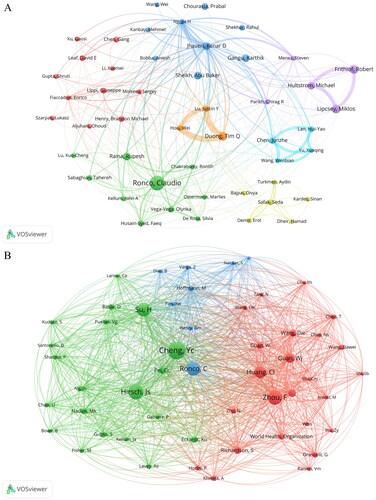
Table 3. The top 10 most publication authors in the field of COVID-19 AKI.
Table 4. The top 10 co-cited authors in the field of COVID-19 AKI.
Institutional analysis
presents the top ten institutions based on publication volume. Among these, Huazhong University of Science and Technology leads in publications, followed by Wuhan University. The majority of institutions in the top ten are from the United States (60%) and China (20%), highlighting these countries as the most prolific contributors in this field. illustrates a network of inter-organizational collaboration created using VOSviewer, displaying a cluster representation of 57 institutions with over 10 publications. These institutions are categorized into seven clusters, representing distinct collaborative groups. Close collaboration is observed within each cluster, as well as cooperative interactions between institutions across different clusters. To provide a more intuitive representation of high-output institutions in this domain, an institution density view () was developed. This visualization highlights the significant presence of Huazhong University of Science and Technology, Wuhan University, Harvard Medical Research Center, Mount Sinai Icahn Medical School, and Columbia University in this field.
Figure 4. Analysis of the institutions. (A) Cluster view. (B) Density view. (A) Institutional clustering view. Each node represents an institution, and the size of the node is proportional to the number of publications of the institution. The thickness of the link between the nodes reflects the intensity of cooperation between the corresponding institutions. Node colors represent different clusters. (B) Institutional density view. The progress from cold to warm colors represents an increase in the number and importance of institutional publications.
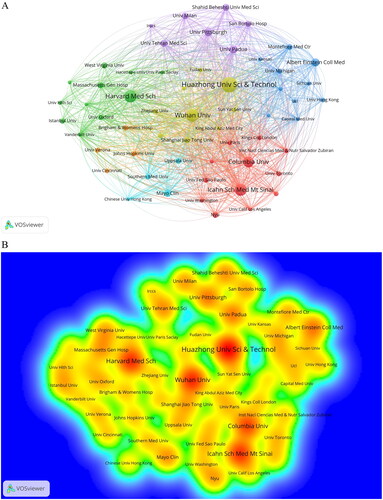
Table 5. The top 10 most publication organizations in the field of COVID-19 AKI.
Country analysis
To investigate the significant contributions made by countries in COVID-19 AKI research, this study conducted an analysis of publication numbers across 100 countries. Initially, VOSviewer was employed to visualize countries with one or more articles. The clustering results are depicted in , showcasing eight clusters, with dominance from the United States, China, Italy, and the United Kingdom across four clusters. Countries within the same cluster exhibit close collaboration, while inter-group cooperation is also evident. The distribution of countries in this field is disparate, emphasizing a top-heavy effect where a majority of papers originate from select nations. Further examination of high-productivity countries is presented in , highlighting the top 10 countries based on total publications in this field. Data analysis from reveals that American researchers have contributed the highest number of research papers (498 papers in total), constituting approximately 33.05% of all papers in this field, albeit with a low average citation rate. Following the US is China, with 229 articles and 20,878 citations, representing the country with the highest citation rate per article. Additionally, illustrates a national analysis network generated by Citespace, demonstrating close collaboration among key countries in this domain.
Figure 5. Analysis of the countries. (A) Cluster view generated by VOSviewer. (B) Network diagram generated by citespace. (A) National clustering view. Each node represents a country, and the size of the node is proportional to the number of publications in the country. The width of the links between nodes corresponds to the intensity of cooperation between the corresponding countries. Node colors represent different clusters. (B) Country analysis. Each node represents a country, and the size of the node is proportional to the amount of literature in the country. The width of the links between nodes reflects the intensity of cooperation between the corresponding countries. The darker the color of the node, the earlier the literature of the country appears. In addition, the nodes covered by the purple circle in the figure represent high centricity (greater than or equal to 0.1).
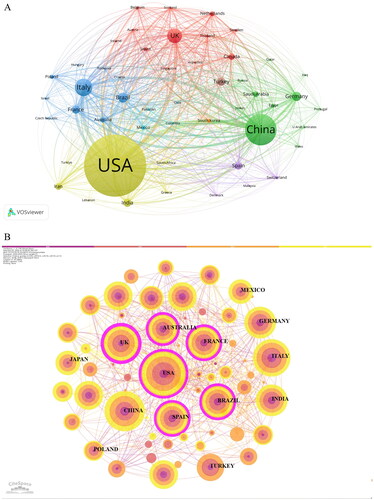
Table 6. The top 10 most publication countries in the field of COVID-19 AKI.
Journal analysis
Analysis of the journals associated with the literature reveals a predominance of publications in the realms of medicine and biology following the onset of the new coronavirus epidemic, with only a minor presence of interdisciplinary journals. The top 10 journals are outlined in , with notable contributions from ‘Journal of Clinical Medicine’, ‘PLOS ONE’, ‘Frontiers in Medicine’, ‘BMC Nephrology’, and ‘Clinical Kidney Journal’, featuring 44, 42, 40, 37, and 25 articles, correspondingly. The journal analysis in reveals that the ‘BMJ – British Medical Journal’ stands out as the most citation journal per article within the medical field, with a total of five articles and an average citation frequency of 757.40 times. Moreover, ‘Kidney International’ emerges as the second most citation journal, with a total of nine papers and an average citation rate of 273.22. Renowned as a leading journal in nephrology research, it is globally acknowledged for its comprehensive coverage of kidney disease development and its ramifications. In accordance with Price’s law, the field necessitates a minimum of 5 core journals, encompassing 72 core journals and 820 articles, constituting approximately 54.41% of the overall article count. illustrates the presence of 72 core journals within this domain, segmented into seven distinct clusters. To elucidate the positioning of COVID-19 AKI research in relation to primary research disciplines and journal interrelationships, a dual-mapping overlay of journals was crafted (See ). The citation curve depicted in the figure comprehensively delineates the nuances of citation dynamics. Leveraging the Z-Scores function, we accentuate robust and seamless citation connections. Notably, the two most prominent green lines in the graph signify a substantial influence of publications in the domains of Molecular/Biology/Genetics/Health/Nursing/Medicine (z = 5.214107, f = 12412) and Hygiene/Nursing (z = 6.145773, f = 14534) on works within the Medicine/Medical/Clinical sphere.
Figure 6. Analysis of the journals. (A) VOSviewer network map of journals. (B) The dual-map overlay of COVID-19-related AKI. (A) Journal clustering view. Each node represents a journal, and the size of the node is proportional to the number of publications in the journal. The width of the links between nodes reflects the strength of cooperation between the corresponding journals. Node colors represent different clusters. (B) Double graph overlay of journals. Each point represents a journal. The map is divided into two parts. The left side is the citation map, the right side is the cited map, the curve is the citation curve, the length of the ellipse represents the number of authors, the width of the ellipse represents the number of publications, and the curve between the left and right parts of the map is the citation link.
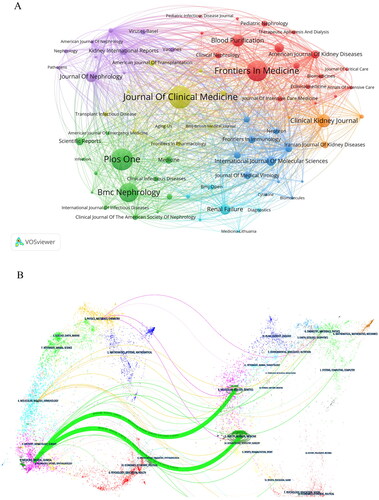
Table 7. The top 10 most publication journals in the field of COVID-19 AKI.
Table 8. The top 10 most citation journals in the field of COVID-19 AKI.
Keyword analysis
Keywords primarily consist of professional terms that serve to encapsulate the fundamental content of research articles. By analyzing keyword co-occurrence, we elucidate the principal research topics within the realm of COVID-19 AKI. The top 10 keywords, ranked by co-occurrence frequency, are enumerated in . depicts a clustered visualization of 134 keywords, each with a frequency greater than or equal to 5 subsequent to screening and merging, organized into 13 distinct color-coded clusters. To provide a more intuitive representation of the research topics in this domain, we have additionally developed a keyword density view (See ), revealing that mortality, intensive care units, and other related aspects constitute the focal points of interest within COVID-19 AKI research.
Figure 7. Keyword co-occurrence analysis. (A) Cluster view. (B) Density view. (A) Each node represents a key phrase. The larger the node is, the higher the frequency of keywords is. The thickness of the edge of the connection node represents the correlation strength between the two keywords, which is measured by the frequency of co-occurrence in the same literature. Node colors represent different clusters. (B) Keyword density view. The progress from cold color to warm color represents the increase of keyword frequency.
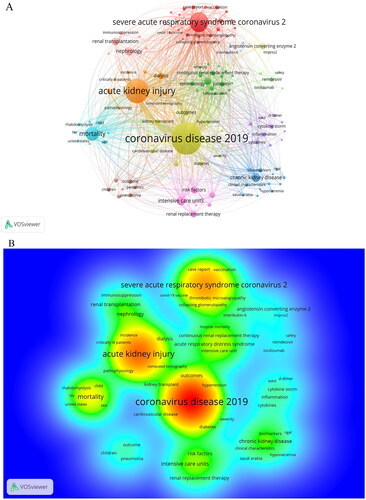
Table 9. The top 20 keywords by co-occurrence frequency in the field of COVID-19 AKI.
References analysis
The references cited in this paper serve as a theoretical foundation and knowledge framework for scientific research. Analyzing these references enables researchers to grasp the current research trends and provides valuable guidance. The co-citation analysis of the references can obtain research topics closely related to specific fields. In the context of COVID-19 AKI, 1507 articles cited a total of 720 references, which were referenced 16,249 times. The top 10 co-cited references are presented in . The most frequently co-cited paper (with 422 citations) is Cheng YC et al.’s ‘Kidney disease is associated with in-hospital death of patients with COVID-19’ published in ‘Kidney International’. This article, a prospective cohort study of adult COVID-19 patients, provides the first report on the association between kidney disease (or renal dysfunction) and in-hospital mortality, indicating a higher risk of in-hospital death among COVID-19 patients with kidney disease [Citation26]. The second most frequently co-cited reference (with 394 citations) is the article by Hirsch JS et al. titled ‘Acute kidney injury in patients with COVID-19’. This article is a retrospective observational cohort study conducted in the large health system of New York, providing insights into the clinical presentations, risk factors, and outcomes of AKI in hospitalized patients with COVID-19. The study reveals a high incidence of AKI in these patients, which is associated with respiratory failure and a poorer prognosis [Citation23]. The article by Zhou F et al. titled ‘Clinical course and risk factors for mortality of adult patients with COVID-19 in Wuhan, China: a retrospective cohort study’, provides a comprehensive account of the risk factors and detailed clinical course leading to mortality in adult patients with COVID-19. This reference ranks as the third most frequently co-cited [Citation25].
Table 10. The top 10 co-cited references in the field of COVID-19 AKI.
presents the visualization of the literature co-cited network using CiteSpace, identifying a total of 13 keyword-based clusters. The S value and the Q value are utilized to evaluate the quality of the clustering outcomes. A greater Q value and S value indicate superior clustering performance and enhanced intra-cluster homogeneity. The Q value for the COVID-19 AKI field is 0.6548, surpassing the threshold of 0.3, signifying the significance of the network structure; similarly, the S value of 0.8428 exceeds 0.7, thereby confirming the credibility of the clustering outcomes. presents the temporal perspective of co-cited references, which proves pivotal in capturing the temporal dynamics of hotspots. The 13 clusters are labeled using keywords and are depicted at varying positions and colors along the timeline corresponding to their respective publication dates. Initially, research in this domain primarily revolved around ‘cytokine release syndrome’ and ‘remdesivir’, with the research focus gradually shifting over time. In 2023, researchers directed their attention toward ‘electron microscopy’, ‘hypertension’, ‘safety’, ‘vaccination’, and ‘tissue inhibitor of metalloproteinases-2’ in relation to COVID-19 AKI.
Figure 8. Analysis of co-cited references. (A) CiteSpace network map of cluster diagram of co-cited references. (B) CiteSpace network map of clustering timeline view of co-cited references. (A) Visual network of co-cited clustering in literature. Tags represent clustering analysis topics, where each node corresponds to a document. The color of the node indicates the release date of the document, and the darker color indicates the earlier release date. (B) Visual representation of 13 clustering timelines. The literatures with the same clustering are arranged on the same horizontal line. Each node represents a document, and the node size is proportional to the co-cited frequency of the document. The publication time of the literature is expressed in color, and the darker the color, the earlier the publication time.
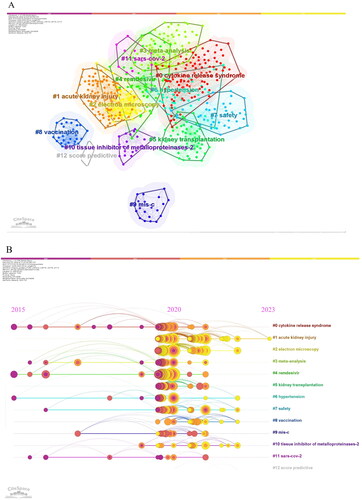
Discussion
This study utilized CiteSpace, VOSviewer, and Pajek software to perform a bibliometric analysis on the research status, hotspots, and trends in the field of COVID-19 AKI using the WoSCC database. A total of 1507 original articles and reviews, published between 1 January 2020 and 31 December 2023, were retrieved. The polynomial fitting curve demonstrates a consistent rise in the quantity of publications in this domain. Despite the deceleration of growth rate attributed to alterations in COVID-19-related policies, the virus persists as a central focus of public scrutiny, with the scientific community persevering in COVID-19-associated investigations. Numerous scientists and medical experts are devoted to investigating the pathogenesis of COVID-19 AKI, elucidating its impact on renal function, biomarkers, imaging indicators, as well as devising patient treatment and management strategies. These studies play a pivotal role in formulating effective prevention and treatment measures [Citation27–34]. Professor Ronco, possessing the most extensive publication record, is a globally acclaimed nephrologist with an esteemed international standing in the domains of acute kidney injury and continuous blood purification. His groundbreaking theories on acute kidney injury and organ support therapy propelled by blood purification have significantly shaped the global landscape of diagnosing and treating renal ailments in critically ill individuals [Citation12,Citation13]. Cheng YC, Hirsch JS, and Zhou F stand out as the top three most pivotal authors in the realm of COVID-19 associated acute kidney injury (AKI). The preeminent journal in this field is the "Bmj-British Medical Journal." Novice researchers can gain insights into the prevailing research focal points by immersing themselves in pertinent literature, thereby facilitating their pursuit of efficient research endeavors. Examination of publication productivity by nation unveils the active engagement of the United States, Italy, and China in research pertaining to COVID-19-induced acute kidney injury, positioning them as the foremost contributors in terms of publication output. Of particular significance is the fact that in Wuhan, the epicenter of the initial COVID-19 outbreak, Huazhong University of Science and Technology and Wuhan University stand out with the highest number of publications and citation frequencies on CAKI research among all research institutions, securing the first and second positions, respectively. Vital financial support from esteemed sources such as the National Natural Science Foundation, the Medical Innovation Fund of the Chinese Academy of Medical Sciences, and the National Key Research and Development Program has been instrumental in bolstering these pivotal studies [Citation35,Citation36]. The data unequivocally demonstrates the substantial contributions of research institutions in China to the realm of COVID-19 research. Furthermore, research establishments in the United States have spearheaded advancements in COVID-19 research, notably in the domains of vaccine development and the prevention and treatment of organ injuries. Examination of articles concerning the productivity of COVID-19-related research reveals that the United States, Italy, and China emerge as significant contributors to publications across disciplines like environmental protection and economics, holding prominent roles [Citation37,Citation38]. Notably, the study unveils China’s surpassing of the United States in research output, both in terms of publication quantity and impact, establishing China as a frontrunner on a global scale [Citation39,Citation40].
Since the onset of the novel coronavirus epidemic, research into COVID-19 AKI has primarily centered on its epidemiological characteristics, risk factors, patient diagnosis, and treatment. Over time, the research focus has shifted toward investigating the pathophysiology of COVID-19 AKI, exploring vaccination, and identifying potential biomarkers. Meint Volbeda et al. extensively investigated the renal histopathological attributes of COVID-19 patients, revealing acute tubular necrosis (ATN) as the most common renal tubular lesion, and collapsing focal segmental glomerulosclerosis (c-FSGS) and thrombotic microangiopathy (TMA) as the most prevalent glomerular lesions [Citation41]. Comparison of renal biopsy results from SARS-CoV-2 infected patients with and without underlying kidney disease revealed the prevalence of AKI in patients without preexisting kidney conditions, while those with such conditions were predisposed to CKD, primarily of the IgA nephropathy (IgAN) type [Citation42]. While kidney disease and other adverse reactions post-COVID-19 vaccination appear to be rare overall, some studies suggest a potential link between COVID-19 vaccination and subsequent kidney disease [Citation43–45]. According to Li Yebei et al. among patients with post-vaccination AKI who undergo kidney biopsy, the most common pathological diagnoses was crescentic glomerulonephritis, followed by acute tubular injury, IgA nephropathy, ANCA-associated vasculitis, minimal change disease, and thrombotic microangiopathy [Citation46]. Research has identified specific biomarkers of renal injury, including functional biomarkers (Cys C), injury biomarkers (KIM-1, NGAL), and stress biomarkers (TIMP-2 and IGFBP7), which may be beneficial for the early diagnosis of COVID-19 AKI [Citation30,Citation47,Citation48].
Acute kidney injury frequently arises in severe and critically ill patients admitted to hospitals for COVID-19 and correlates with disease severity, prognosis, and mortality. These findings substantiate the strong association between acute kidney injury and COVID-19 [Citation49,Citation50]. While studies have identified a higher risk of severe illness or mortality among elderly individuals with underlying conditions following SARS-CoV-2 infection, the precise pathogenic mechanism of the virus remains incompletely understood. Nonetheless, notable research findings have emerged, offering valuable information regarding the direct or indirect mechanisms by which COVID-19 induces AKI. SARS-CoV-2 directly invades the renal parenchyma by engaging its receptor, angiotensin-converting enzyme 2 (ACE2), in conjunction with transmembrane protease serine 2 (TMPRSS2), thereby constituting the primary mechanism underlying AKI induced by COVID-19 [Citation51–53]. However, this perspective remains a subject of debate. Robert Frithiof et al. observed the infrequency of SARS-CoV-2 in the urine of critically ill patients with COVID-19 and postulated that AKI in these patients is not associated with viral infection [Citation54]. Renal biopsy results from some COVID-19 patients also challenge the notion of direct viral infection as a cause of AKI [Citation55–57]. Furthermore, several authors have raised doubts about whether reports of viral particles in the kidneys of COVID-19 patients misidentified normal endosomal subcellular structures [Citation58]. It is evident that we should recognize the significance of indirect mechanisms. For example, interfering with immune responses and cytokine storms can deplete lymphocytes, impede virus clearance, and consequently impair kidney function [Citation59,Citation60]; rhabdomyolysis induction can also lead to renal damage [Citation61,Citation62]; organ crosstalk via the lung-kidney axis or heart-kidney axis may contribute to renal injury [Citation13, Citation63–65]. Therefore, a comprehensive understanding of the pathogenesis of novel coronavirus infection is pivotal for the prevention and treatment of COVID-19-associated acute kidney injury.
Research limitations
This study faces three primary limitations. Firstly, the reliance on a singular literature source, specifically SCI-E of WoSCC, may result in the omission of crucial relevant literature not covered comprehensively, potentially leading to the exclusion of significant literature in this domain. Secondly, the inclusion of literature limited to English may inadvertently disregard significant research findings and perspectives expressed in alternative languages. Finally, due to the bibliometric analysis’s emphasis on investigating the more dynamic facets of a discipline, it may overlook advancements in certain critical domains.
Conclusion
This study conducted a comprehensive review of publications related to acute kidney injury in past COVID-19 research using bibliometric methods. It highlighted the contributions made by the United States, China, and Italy in this field. The bibliometric analysis provides a reference for future research on the mechanisms of COVID-19-induced kidney injury as well as its prevention and treatment.
Author contributions
ZWJ and TRZ designed this study and collected data. ZWJ and GJ analyzed the data and wrote the original draft. SHW, WL and LJ modified and polished the manuscript. All authors have read and approved the final manuscript.
Supplemental Material
Download PDF (91.2 KB)Disclosure statement
No potential conflict of interest was reported by the author(s).
Additional information
Funding
References
- Ostermann M, Bellomo R, Burdmann EA, et al. Controversies in acute kidney injury: conclusions from a kidney disease: improving global outcomes (KDIGO) conference. Kidney Int. 2020;98(2):1–17. doi: 10.1016/j.kint.2020.04.020.
- Coronavirus disease (COVID-19). https://www.who.int/news-room/fact-sheets/detail/coronavirus-disease-(covid-19).
- Zheng KI, Feng G, Liu WY, et al. Extrapulmonary complications of COVID-19: a multisystem disease?. J Med Virol. 2021;93(1):323–335. doi: 10.1002/jmv.26294.
- Nadim MK, Forni LG, Mehta RL, et al. COVID-19-associated acute kidney injury: consensus report of the 25th acute disease quality initiative (ADQI) workgroup. Nat Rev Nephrol. 2020;16(12):747–764. doi:10/gjnj2s.
- Legrand M, Bell S, Forni L, et al. Pathophysiology of COVID-19-associated acute kidney injury. Nat Rev Nephrol. 2021;17(11):751–764. doi: 10/gk5qgh.
- Teixeira JP, Barone S, Zahedi K, et al. Kidney injury in COVID-19: epidemiology, molecular mechanisms and potential therapeutic targets. Int J Mol Sci. 2022;23(4):2242. doi: 10/gq73ks.
- Gabarre P, Dumas G, Dupont T, et al. Acute kidney injury in critically ill patients with COVID-19. Intensive Care Med. 2020;46(7):1339–1348. doi:10/gg525w.
- Ng JH, Hirsch JS, Hazzan A, et al. Outcomes among patients hospitalized with COVID-19 and acute kidney injury. Am J Kidney Dis. 2021;77(2):204–215.e1. doi: 10.1053/j.ajkd.2020.09.002.
- Lumlertgul N, Pirondini L, Cooney E, et al. Acute kidney injury prevalence, progression and long-term outcomes in critically ill patients with COVID-19: a cohort study. Ann Intensive Care. 2021;11(1):123. doi: 10/gp6xvs.
- Pan W, Zheng P, Huang J, et al. Research hotspot detection of health information based on the“DEAN”process of data clean. J. Modern Inform. 2018;38(10):73–77.
- Statement on the fifteenth meeting of the IHR. 2005. Emergency Committee on the COVID-19 pandemic. https://www.who.int/news/item/05-05-2023-statement-on-the-fifteenth-meeting-of-the-international-health-regulations-(2005)-emergency-committee-regarding-the-coronavirus-disease-(covid-19)-pandemic.
- Villa G, Romagnoli S, De Rosa S, et al. Blood purification therapy with a hemodiafilter featuring enhanced adsorptive properties for cytokine removal in patients presenting COVID-19: a pilot study. Crit Care. 2020;24(1):605. doi: 10.1186/s13054-020-03322-6.
- Ronco C, Reis T, Husain-Syed F. Management of acute kidney injury in patients with COVID-19. Lancet Respir Med. 2020;8(7):738–742. doi: 10.1016/S2213-2600(20)30229-0.
- Wang F, Ran L, Qian C, et al. Epidemiology and outcomes of acute kidney injury in COVID-19 patients with acute respiratory distress syndrome: a multicenter retrospective study. Blood Purif. 2021;50(4-5):499–505. doi: 10.1159/000512371.
- Lu JY, Boparai MS, Shi C, et al. Long-term outcomes of COVID-19 survivors with hospital AKI: association with time to recovery from AKI. Nephrol Dial Transplant. 2023;38(10):2160–2169. doi: 10.1093/ndt/gfad020.
- Hoogenboom WS, Lu JQ, Musheyev B, et al. Prophylactic versus therapeutic dose anticoagulation effects on survival among critically ill patients with COVID-19. PLoS One. 2022;17(1):e0262811. doi: 10.1371/journal.pone.0262811.
- Sancho Ferrando E, Hanslin K, Hultström M, et al. Soluble TNF receptors predict acute kidney injury and mortality in critically ill COVID-19 patients: a prospective observational study. Cytokine. 2022;149:155727. doi: 10.1016/j.cyto.2021.155727.
- Luther T, Eckerbom P, Cox E, et al. Decreased renal perfusion during acute kidney injury in critical COVID-19 assessed by magnetic resonance imaging: a prospective case control study. Crit Care. 2022;26(1):262. doi: 10.1186/s13054-022-04132-8.
- Tsai MS, Shih WT, Yang YH, et al. Potential inhibitor for blocking binding between ACE2 and SARS-CoV-2 spike protein with mutations. Biomed Pharmacother. 2022;149:112802. doi: 10.1016/j.biopha.2022.112802.
- Weidenbacher PAB, Waltari E, De Los RiosKobara I, et al. Converting non-neutralizing SARS-CoV-2 antibodies into broad-spectrum inhibitors. Nat Chem Biol. 2022;18(11):1270–1276. doi: 10.1038/s41589-022-01140-1.
- Weidenbacher PAB, Sanyal M, Friedland N, et al. Author correction: a ferritin-based COVID-19 nanoparticle vaccine that elicits robust, durable, broad-spectrum neutralizing antisera in non-human primates. Nat Commun. 2023;14(1):6211. doi: 10.1038/s41467-023-42061-4.
- Fishbane S, Hirsch JS. Erythropoiesis-stimulating agent treatment in patients with COVID-19. Am J Kidney Dis. 2020;76(3):303–305. doi: 10.1053/j.ajkd.2020.05.002.
- Hirsch JS, Ng JH, Ross DW, et al. Acute kidney injury in patients hospitalized with COVID-19. Kidney Int. 2020;98(1):209–218. doi: 10/ggx24k.
- Wang Y, Zhang D, Du G, et al. Remdesivir in adults with severe COVID-19: a randomised, double-blind, placebo-controlled, multicentre trial. Lancet. 2020;395(10236):1569–1578. doi: 10.1016/S0140-6736(20)31022-9.
- Zhou F, Yu T, Du R, et al. Clinical course and risk factors for mortality of adult inpatients with COVID-19 in Wuhan, China: a retrospective cohort study. Lancet. 2020;395(10229):1054–1062. doi: 10.1016/S0140-6736(20)30566-3.
- Cheng Y, Luo R, Wang K, et al. Kidney disease is associated with in-hospital death of patients with COVID-19. Kidney Int. 2020;97(5):829–838. doi: 10/ggppqm.
- Giguère P, Deschenes MJ, Van Loon M, et al. Management and outcome of COVID-19 infection using nirmatrelvir/ritonavir in kidney transplant patients. Clin J Am Soc Nephrol. 2023;18(7):913–919. doi: 10.2215/CJN.0000000000000186.
- Xu K, Shang N, Levitman A, et al. Elevated neutrophil gelatinase-associated lipocalin is associated with the severity of kidney injury and poor prognosis of patients with COVID-19. Kidney Int Rep. 2021;6(12):2979–2992. doi: 10.1016/j.ekir.2021.09.005.
- Menez S, Moledina DG, Thiessen-Philbrook H, et al. Prognostic significance of urinary biomarkers in patients hospitalized with COVID-19. Am J Kidney Dis. 2022;79(2):257–267.e1. doi: 10.1053/j.ajkd.2021.09.008.
- Xiao Z, Huang Q, Yang Y, et al. Emerging early diagnostic methods for acute kidney injury[J]. Theranostics. 2022;12(6):2963–2986. doi: 10.7150/thno.71064.
- Qian JY, Wang B, Lv LL, et al. Pathogenesis of acute kidney injury in coronavirus disease 2019. Front Physiol. 2021;12:586589. doi: 10.3389/fphys.2021.586589.
- Al Rumaihi K, Khalafalla K, Arafa M, et al. COVID-19 and renal involvement: a prospective cohort study assessing the impact of mild SARS-CoV-2 infection on the kidney function of young healthy males. Int Urol Nephrol. 2022;55(1):201–209. doi: 10.1007/s11255-022-03301-6.
- Mottaghi A, Alipour F, Alibeik N, et al. Serum cystatin C and inflammatory factors related to COVID-19 consequences. BMC Infect Dis. 2023;23(1):339. doi: 10.1186/s12879-023-08258-0.
- Wu W, Wang W, Liang L, et al. Treatment with quercetin inhibits SARS-CoV-2 N protein-induced acute kidney injury by blocking Smad3-dependent G1 cell-cycle arrest. Mol Ther. 2022;31(2):344–361. doi: 10.1016/j.ymthe.2022.12.002.
- Huang C, Huang L, Wang Y, et al. 6-month consequences of COVID-19 in patients discharged from hospital: a cohort study. Lancet. 2023;401(10393):e21–e33. doi: 10.1016/S0140-6736(23)00810-3.
- Gu X, Huang L, Cui D, et al. Association of acute kidney injury with 1-year outcome of kidney function in hospital survivors with COVID-19: a cohort study. EBioMedicine. 2022;76:103817. doi: 10.1016/j.ebiom.2022.103817.
- Zhong M, Lin M. Bibliometric analysis for economy in COVID-19 pandemic. Heliyon. 2022;8(9):e10757. https://www.ncbi.nlm.nih.gov/pmc/articles/PMC9509534/. doi: 10.1016/j.heliyon.2022.
- Wang Q, Zhang M, Li R. The COVID-19 pandemic reshapes the plastic pollution research – a comparative analysis of plastic pollution research before and during the pandemic. Environ Res. 2022;208:112634. doi: 10.1016/j.envres.2021.112634.
- Miller RC, Tsai CJ. Scholarly publishing in the wake of COVID-19. Int J Radiat Oncol Biol Phys. 2020;108(2):491–495. doi: 10.1016/j.ijrobp.2020.06.048.
- China overtakes US in scientific research output[EB]//MCLC Resource Center. 2022. https://u.osu.edu/mclc/2022/08/11/china-overtakes-us-in-scientific-research-output/.
- Volbeda M, Jou-Valencia D, Van Den Heuvel MC, et al. Acute and chronic histopathological findings in renal biopsies in COVID-19. Clin Exp Med. 2022;23(4):1003–1014. doi: 10.1007/s10238-022-00941-x.
- Qi Z, Yuan S, Wei J, et al. Clinical and pathological features of omicron variant of SARS-CoV-2-associated kidney injury. J Med Virol. 2023;95(10):e29196. doi: 10.1002/jmv.29196.
- Pantazis N, Pechlivanidou E, Antoniadou A, et al. Remdesivir: effectiveness and safety in hospitalized patients with COVID-19 (ReEs-COVID-19)-analysis of data from daily practice. Microorganisms. 2023;11(8):1998. doi: 10.3390/microorganisms11081998.
- Wang Y, Yang L, Xu G. New-onset acute interstitial nephritis post-SARS-CoV-2 infection and COVID-19 vaccination: a panoramic review. J Epidemiol Glob Health. 2023;13(4):615–636. doi: 10.1007/s44197-023-00159-4.
- Y S, D K, K H, et al. Renal biopsy diagnosis of acute tubular injury after Pfizer-BioNTech COVID-19 vaccination: a case report. Vaccines. 2023;11(2):464. https://pubmed.ncbi.nlm.nih.gov/36851341/. doi: 10.3390/vaccines11020464.
- Li Y, Gong Y, Xu G. New insights into kidney disease after COVID-19 infection and vaccination: histopathological and clinical findings. QJM. 2023:hcad159. doi: 10.1093/qjmed/hcad159.
- Su L, Zhang J, Peng Z. The role of kidney injury biomarkers in COVID-19. Ren Fail. 2022;44(1):1280–1288. doi: 10/gq73hz.
- Weiss R, Von Groote T, Ostermann M, et al. The role of cell cycle arrest biomarkers for predicting acute kidney injury in critically ill COVID-19 patients: a multicenter, observational study. Crit Care Med. 2023;51(8):992–1000. doi: 10.1097/CCM.0000000000005853.
- Głowacka M, Lipka S, Młynarska E, et al. Acute kidney injury in COVID-19. Int J Mol Sci. 2021;22(15):8081. doi: 10/gq73h5.
- Chan L, Chaudhary K, Saha A, et al. AKI in hospitalized patients with COVID-19. J Am Soc Nephrol. 2021;32(1):151–160. doi: 10/ghvb7m.
- Hoffmann M, Kleine-Weber H, Schroeder S, et al. SARS-CoV-2 cell entry depends on ACE2 and TMPRSS2 and is blocked by a clinically proven protease inhibitor. Cell. 2020;181(2):271–280.e8. doi: 10/ggnq74.
- Pan XW, Xu D, Zhang H, et al. Identification of a potential mechanism of acute kidney injury during the COVID-19 outbreak: a study based on single-cell transcriptome analysis. Intensive Care Med. 2020;46(6):1114–1116. doi: 10/ggq72d.
- Diao B, Wang C, Wang R, et al. Human kidney is a target for novel severe acute respiratory syndrome coronavirus 2 infection. Nat Commun. 2021;12(1):2506. doi: 10/gkcz2x.
- R F, A B, Jd J, et al. Presence of SARS-CoV-2 in urine is rare and not associated with acute kidney injury in critically ill COVID-19 patients. Critical Care (London, England). 2020;24(1):587. https://pubmed.ncbi.nlm.nih.gov/32993742/. doi: 10.1186/s13054-020-03302-w.
- Sharma P, Uppal NN, Wanchoo R, et al. COVID-19–associated kidney injury: a case series of kidney biopsy findings. J Am Soc Nephrol. 2020;31(9):1948–1958. doi: 10/gq73mb.
- May RM, Cassol C, Hannoudi A, et al. A multi-center retrospective cohort study defines the spectrum of kidney pathology in coronavirus 2019 disease (COVID-19). Kidney Int. 2021;100(6):1303–1315. doi: 10/gmgnsm.
- Santoriello D, Khairallah P, Bomback AS, et al. Postmortem kidney pathology findings in patients with COVID-19. J Am Soc Nephrol. 2020;31(9):2158–2167. doi: 10.1681/ASN.2020050744.
- Goldsmith CS, Miller SE, Martines RB, et al. Electron microscopy of SARS-CoV-2: a challenging task. Lancet. 2020;395(10238):e99. doi: 10.1016/S0140-6736(20)31188-0.
- Li X, Geng M, Peng Y, et al. Molecular immune pathogenesis and diagnosis of COVID-19. J Pharm Anal. 2020;10(2):102–108. doi: 10/ggppqg.
- Qin C, Zhou L, Hu Z, et al. Dysregulation of immune response in patients with COVID-19 in Wuhan, China. Clin Inf Dis. 2020;71(15):762–768. doi: 10/ggpxcf.
- Fadila MF, Wool KJ. Rhabdomyolysis secondary to influenza a infection: a case report and review of the literature. N Am J Med Sci. 2015;7(3):122–124. doi: 10.4103/1947-2714.153926.
- Suwanwongse K, Shabarek N. Rhabdomyolysis as a presentation of 2019 novel coronavirus disease. Cureus. 2022;12(4):e7561. doi: 10/ggq9zh.
- Ronco C, Reis T. Kidney involvement in COVID-19 and rationale for extracorporeal therapies. Nat Rev Nephrol. 2020;16(6):308–310. doi: 10/ggr2r7.
- Panitchote A, Mehkri O, Hastings A, et al. Factors associated with acute kidney injury in acute respiratory distress syndrome. Ann Intensive Care. 2019;9(1):74. doi: 10.1186/s13613-019-0552-5.
- Fanelli V, Fiorentino M, Cantaluppi V, et al. Acute kidney injury in SARS-CoV-2 infected patients. Crit Care. 2020;24(1):155. doi: 10.1186/s13054-020-02872-z.

